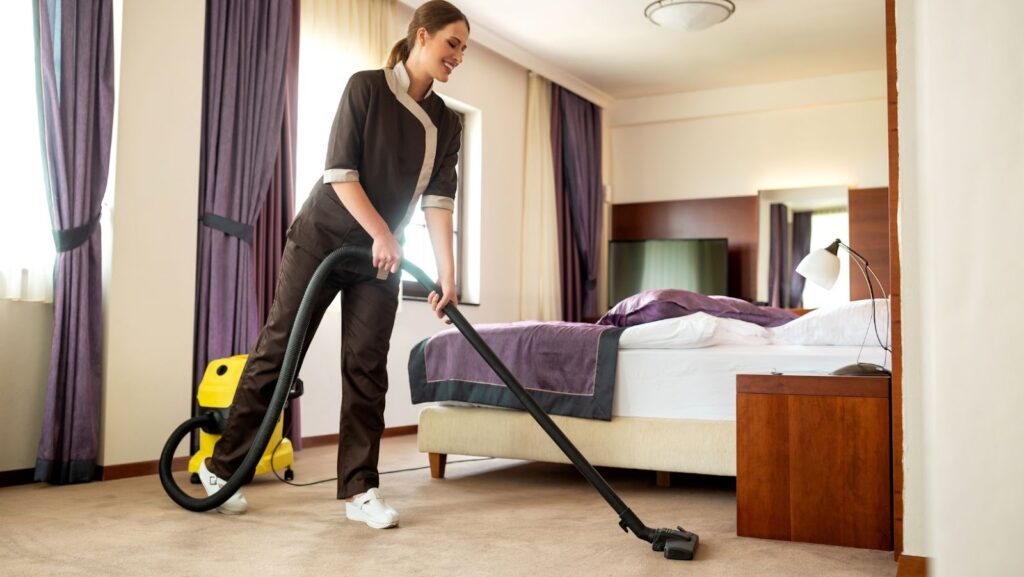Table of Contents
ToggleHow Does a Vacuum Work
Curious about how a vacuum works? Let me break it down for you. A vacuum cleaner is a handy household appliance that helps keep our floors clean and free from dust, dirt, and debris. But have you ever wondered what goes on inside this seemingly simple machine?
At its core, a vacuum cleaner operates on the principle of suction. When you turn on the vacuum, it creates a partial vacuum by removing air from its enclosed space. As a result, the pressure inside the vacuum decreases, creating suction power.
The suction power allows the vacuum to pull in dirt and debris through an intake port or nozzle. This dirty air is then circulated through various filters within the machine, which trap the particles while allowing air to pass through. Finally, the filtered air is released back into your home, leaving your floors clean and fresh.
So next time you use your trusty vacuum cleaner, remember that it’s harnessing the power of suction to make your cleaning tasks easier. With its clever design and efficient airflow system, it’s no wonder vacuums have become an essential tool in maintaining a tidy home.
Now that we’ve covered the basics of how a vacuum works let’s dive deeper into its inner workings. Stay tuned for more fascinating insights into this everyday marvel!

The Basics of Vacuum Cleaners
When it comes to cleaning our homes, vacuum cleaners are an essential tool. But have you ever wondered how these machines actually work? Let’s dive into the basics of vacuum cleaners and uncover the fascinating science behind them.
- Suction Power: At the heart of every vacuum cleaner is its suction power. It’s this force that allows the machine to pull in dirt, dust, and debris from various surfaces. How does it achieve this?
- Motor and Fan: Vacuum cleaners use an electric motor to generate powerful airflow. This motor spins a fan rapidly, creating a strong suction force by drawing air into the machine.
- Airflow and Pressure Difference: As air is drawn into the vacuum cleaner, it passes through a series of filters that trap particles while allowing air to continue flowing. The resulting pressure difference between the outside and inside of the cleaner creates suction.
- Nozzle and Brushes: The nozzle at the end of the vacuum cleaner directs airflow towards the surface being cleaned. Some models also have rotating brushes that agitate carpet fibers or dislodge dirt from hard floors, making it easier for suction to pick up debris.
- Dust Collection: As dirt and dust are pulled into the vacuum cleaner, they pass through another filter or dust bag where they are collected, separating them from clean air before it is released back into the room.
- Different Types of Vacuums: There are various types of vacuums available on the market today, each designed for specific purposes:
- Upright vacuums: These are versatile machines commonly used for everyday cleaning tasks.
- Canister vacuums: With their separate canister unit connected via a hose, these provide greater maneuverability.
- Robot vacuums: These autonomous devices navigate around your home using sensors to detect obstacles and clean floors automatically.
- Handheld vacuums: Compact and portable, these are perfect for quick clean-ups and reaching small, tight spaces.
The Basics of Vacuum Cleaners
When it comes to cleaning our homes, vacuum cleaners are an essential tool. But have you ever wondered how these machines actually work? Let’s dive into the basics of vacuum cleaners and uncover the fascinating science behind them.
- Suction Power: At the heart of every vacuum cleaner is its suction power. It’s this force that allows the machine to pull in dirt, dust, and debris from various surfaces. How does it achieve this?
- Motor and Fan: Vacuum cleaners use an electric motor to generate powerful airflow. This motor spins a fan rapidly, creating a strong suction force by drawing air into the machine.
- Airflow and Pressure Difference: As air is drawn into the vacuum cleaner, it passes through a series of filters that trap particles while allowing air to continue flowing. The resulting pressure difference between the outside and inside of the cleaner creates suction.
- Nozzle and Brushes: The nozzle at the end of the vacuum cleaner directs airflow towards the surface being cleaned. Some models also have rotating brushes that agitate carpet fibers or dislodge dirt from hard floors, making it easier for suction to pick up debris.
- Dust Collection: As dirt and dust are pulled into the vacuum cleaner, they pass through another filter or dust bag where they are collected, separating them from clean air before it is released back into the room.
- Different Types of Vacuums: There are various types of vacuums available on the market today, each designed for specific purposes:
- Upright vacuums: These are versatile machines commonly used for everyday cleaning tasks.
- Canister vacuums: With their separate canister unit connected via a hose, these provide greater maneuverability.
- Robot vacuums: These autonomous devices navigate around your home using sensors to detect obstacles and clean floors automatically.
- Handheld vacuums: Compact and portable, these are perfect for quick clean-ups and reaching small, tight spaces.
- Maintenance: To ensure optimal performance, regular maintenance is crucial. This includes emptying or replacing dust bags, cleaning filters, checking for clogs in the hoses or brushes, and inspecting the overall condition of the vacuum cleaner.

